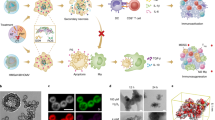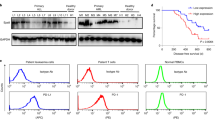Abstract
Immunostimulatory monoclonal antibodies are immunoglobulins directed toward surface proteins of immune system cells that augment the immune response against cancer in a novel therapeutic fashion. Exogenous administration of the recombinant humanized immunoglobulins is being tested in clinical trials with agents of this kind directed at a variety of immune-controlling molecular targets. In this study, the encapsulation of antibody-producing hybridoma cells was tested in comparison with the systemic administration of monoclonal antibodies. Hybridomas producing anti-CD137 and anti-OX40 mAb were encapsulated in alginate to generate microcapsules containing viable cells that secrete antibody. Immobilized cells in vitro were able to release the rat immunoglobulin produced by the hybridomas into the supernatant. Microcapsules were implanted by injection into the subcutaneous tissue of mice and thereby provided a platform for viable secreting cells, which lasted for more than 1 week. The pharmacokinetic profile of the rat monoclonal antibodies following microcapsule implantation was similar to that attained following an intraperitoneal administration of the purified antibodies. The rat–mouse hybridoma cells did not engraft as tumors in immunocompetent mice, while they lethally xenografted in immunodeficient mice, if not microencapsulated. The antitumor therapeutic activity of the strategy was studied on established CT26 colon carcinomas resulting in complete tumor eradication in an elevated fraction of cases and strong tumor-specific CTL responses with either anti-CD137 or anti-OX40 producing hybridomas, thus offering proof of the concept. This form of administration permitted combinations of more than one immunostimulatory monoclonal antibody to exploit the synergistic effects such as those known to be displayed by anti-CD137 and anti-OX40 mAb.






Similar content being viewed by others
Abbreviations
- mAb:
-
Monoclonal antibody
- DC:
-
Dendritic cell
- TNF:
-
Tumor necrosis factor
- NK:
-
Natural killer
- APA:
-
Alginate-poly-l-lysine-alginate
References
Melero I, Hervas-Stubbs S, Glennie M, Pardoll DM, Chen L (2007) Immunostimulatory monoclonal antibodies for cancer therapy. Nat Rev Cancer 7:95–106
Murillo O, Arina A, Tirapu I et al (2003) Potentiation of therapeutic immune responses against malignancies with monoclonal antibodies. Clin Cancer Res 9:5454–5464
Korman AJ, Peggs KS, Allison JP (2006) Checkpoint blockade in cancer immunotherapy. Adv Immunol 90:297–339
Weber J (2009) Ipilimumab: controversies in its development, utility and autoimmune adverse events. Cancer Immunol Immunother 58:823–830
Fong L, Small EJ (2008) Anti-cytotoxic T-lymphocyte antigen-4 antibody: the first in an emerging class of immunomodulatory antibodies for cancer treatment. J Clin Oncol 26:5275–5283
Vonderheide RH, Flaherty KT, Khalil M et al (2007) Clinical activity and immune modulation in cancer patients treated with CP-870, 893, a novel CD40 agonist monoclonal antibody. J Clin Oncol 25:876–883
Suntharalingam G, Perry MR, Ward S et al (2006) Cytokine storm in a phase 1 trial of the anti-CD28 monoclonal antibody TGN1412. N Engl J Med 355:1018–1028
Uno T, Takeda K, Kojima Y et al (2006) Eradication of established tumors in mice by a combination antibody-based therapy. Nat Med 12:693–698
Kocak E, Lute K, Chang X et al (2006) Combination therapy with anti-CTL antigen-4 and anti-4-1BB antibodies enhances cancer immunity and reduces autoimmunity. Cancer Res 66:7276–7284
Gray JC, French RR, James S, Al-Shamkhani A, Johnson PW, Glennie MJ (2008) Optimising anti-tumour CD8 T-cell responses using combinations of immunomodulatory antibodies. Eur J Immunol 38:2499–2511
Pardoll D, Allison J (2004) Cancer immunotherapy: breaking the barriers to harvest the crop. Nat Med 10:887–892
Croft M (2009) The role of TNF superfamily members in T-cell function and diseases. Nat Rev Immunol 9:271–285
Watts TH (2005) TNF/TNFR family members in costimulation of T cell responses. Annu Rev Immunol 23:23–68
Weinberg AD, Rivera MM, Prell R et al (2000) Engagement of the OX-40 receptor in vivo enhances antitumor immunity. J Immunol 164:2160–2169
Melero I, Shuford WW, Newby SA et al (1997) Monoclonal antibodies against the 4-1BB T-cell activation molecule eradicate established tumors. Nat Med 3:682–685
Munks MW, Mourich DV, Mittler RS, Weinberg AD, Hill AB (2004) 4-1BB and OX40 stimulation enhance CD8 and CD4 T-cell responses to a DNA prime, poxvirus boost vaccine. Immunology 112:559–566
Cuadros C, Dominguez AL, Lollini PL et al (2005) Vaccination with dendritic cells pulsed with apoptotic tumors in combination with anti-OX40 and anti-4-1BB monoclonal antibodies induces T cell-mediated protective immunity in Her-2/neu transgenic mice. Int J Cancer 116:934–943
Murua A, Portero A, Orive G, Hernandez RM, de Castro M, Pedraz JL (2008) Cell microencapsulation technology: towards clinical application. J Control Release 132:76–83
Calafiore R, Basta G, Luca G et al (2006) Microencapsulated pancreatic islet allografts into nonimmunosuppressed patients with type 1 diabetes: first two cases. Diabetes Care 29:137–138
Lohr M, Hoffmeyer A, Kroger J et al (2001) Microencapsulated cell-mediated treatment of inoperable pancreatic carcinoma. Lancet 357:1591–1592
Orive G, Hernandez RM, Gascon AR et al (2003) Cell encapsulation: promise and progress. Nat Med 9:104–107
Wilson JT, Chaikof EL (2008) Challenges and emerging technologies in the immunoisolation of cells and tissues. Adv Drug Deliv Rev 60:124–145
Wilcox RA, Flies DB, Zhu G et al (2002) Provision of antigen and CD137 signaling breaks immunological ignorance, promoting regression of poorly immunogenic tumors. J Clin Invest 109:651–659
Valzasina B, Guiducci C, Dislich H, Killeen N, Weinberg AD, Colombo MP (2005) Triggering of OX40 (CD134) on CD4(+)CD25+ T cells blocks their inhibitory activity: a novel regulatory role for OX40 and its comparison with GITR. Blood 105:2845–2851
Lim F, Sun AM (1980) Microencapsulated islets as bioartificial endocrine pancreas. Science 210:908–910
Ponce S, Orive G, Hernandez RM et al (2006) In vivo evaluation of EPO-secreting cells immobilized in different alginate-PLL microcapsules. J Control Release 116:28–34
Huang AY, Gulden PH, Woods AS et al (1996) The immunodominant major histocompatibility complex class I-restricted antigen of a murine colon tumor derives from an endogenous retroviral gene product. Proc Natl Acad Sci USA 93:9730–9735
Casares N, Lasarte JJ, de Cerio AL et al (2001) Immunization with a tumor-associated CTL epitope plus a tumor-related or unrelated Th1 helper peptide elicits protective CTL immunity. Eur J Immunol 31:1780–1789
Murillo O, Dubrot J, Palazon A et al (2009) In vivo depletion of DC impairs the anti-tumor effect of agonistic anti-CD137 mAb. Eur J Immunol 39:2424–2436
Mittler RS, Bailey TS, Klussman K, Trailsmith MD, Hoffmann MK (1999) Anti-4-1BB monoclonal antibodies abrogate T cell-dependent humoral immune responses in vivo through the induction of helper T cell anergy. J Exp Med 190:1535–1540
Seo SK, Choi JH, Kim YH et al (2004) 4-1BB-mediated immunotherapy of rheumatoid arthritis. Nat Med 10:1088–1094
Sun Y, Blink SE, Chen JH, Fu YX (2005) Regulation of follicular dendritic cell networks by activated T cells: the role of CD137 signaling. J Immunol 175:884–890
Mazzolini G, Murillo O, Atorrasagasti C et al (2007) Immunotherapy and immunoescape in colorectal cancer. World J Gastroenterol 13:5822–5831
Melero I, Murillo O, Dubrot J, Hervas-Stubbs S, Perez-Gracia JL (2008) Multi-layered action mechanisms of CD137 (4-1BB)-targeted immunotherapies. Trends Pharmacol Sci 29:383–390
Beck A, Wurch T, Bailly C, Corvaia N (2010) Strategies and challenges for the next generation of therapeutic antibodies. Nat Rev Immunol 10:345–352
Miller RE, Jones J, Le T et al (2002) 4-1BB-specific monoclonal antibody promotes the generation of tumor-specific immune responses by direct activation of CD8 T cells in a CD40-dependent manner. J Immunol 169:1792–1800
Murillo O, Arina A, Hervas-Stubbs S et al (2008) Therapeutic antitumor efficacy of anti-CD137 agonistic monoclonal antibody in mouse models of myeloma. Clin Cancer Res 14:6895–6906
Weinberg AD (2002) OX40: targeted immunotherapy–implications for tempering autoimmunity and enhancing vaccines. Trends Immunol 23:102–109
Gough MJ, Ruby CE, Redmond WL, Dhungel B, Brown A, Weinberg AD (2008) OX40 agonist therapy enhances CD8 infiltration and decreases immune suppression in the tumor. Cancer Res 68:5206–5215
Piconese S, Valzasina B, Colombo MP (2008) OX40 triggering blocks suppression by regulatory T cells and facilitates tumor rejection. J Exp Med 205:825–839
Grandoso L, Ponce S, Manuel I et al (2007) Long-term survival of encapsulated GDNF secreting cells implanted within the striatum of parkinsonized rats. Int J Pharm 343:69–78
Murua A, de Castro M, Orive G, Hernandez RM, Pedraz JL (2007) In vitro characterization and in vivo functionality of erythropoietin-secreting cells immobilized in alginate-poly-l-lysine-alginate microcapsules. Biomacromolecules 8:3302–3307
McLenachan S, Sarsero JP, Ioannou PA (2007) Flow-cytometric analysis of mouse embryonic stem cell lipofection using small and large DNA constructs. Genomics 89:708–720
Orive G, Tam SK, Pedraz JL, Halle JP (2006) Biocompatibility of alginate-poly-l-lysine microcapsules for cell therapy. Biomaterials 27:3691–3700
Orive G, De Castro M, Kong HJ et al (2009) Bioactive cell-hydrogel microcapsules for cell-based drug delivery. J Control Release 135:203–210
French RR, Taraban VY, Crowther GR et al (2007) Eradication of lymphoma by CD8 T cells following anti-CD40 monoclonal antibody therapy is critically dependent on CD27 costimulation. Blood 109:4810–4815
Pentcheva-Hoang T, Egen JG, Wojnoonski K, Allison JP (2004) B7-1 and B7-2 selectively recruit CTLA-4 and CD28 to the immunological synapse. Immunity 21:401–413
de Vos P, Faas MM, Strand B, Calafiore R (2006) Alginate-based microcapsules for immunoisolation of pancreatic islets. Biomaterials 27:5603–5617
Orive G, De Castro M, Ponce S et al (2005) Long-term expression of erythropoietin from myoblasts immobilized in biocompatible and neovascularized microcapsules. Mol Ther 12:283–289
Zhang H, Zhu SJ, Wang W, Wei YJ, Hu SS (2008) Transplantation of microencapsulated genetically modified xenogeneic cells augments angiogenesis and improves heart function. Gene Ther 15:40–48
Tobias CA, Han SS, Shumsky JS et al (2005) Alginate encapsulated BDNF-producing fibroblast grafts permit recovery of function after spinal cord injury in the absence of immune suppression. J Neurotrauma 22:138–156
Teng H, Zhang Y, Wang W, Ma X, Fei J (2007) Inhibition of tumor growth in mice by endostatin derived from abdominal transplanted encapsulated cells. Acta Biochim Biophys Sin (Shanghai) 39:278–284
Sangro B, Melero I, Qian C, Prieto J (2005) Gene therapy of cancer based on interleukin 12. Curr Gene Ther 5:573–581
Acknowledgments
We are grateful to Drs. Lieping Chen for the kind gift of the 2A hybridoma and Mario Colombo for OX86 cells. Elena Ciordia and Eneko Elizalde are acknowledged for their excellent animal facility management. We received financial support from MEC/MICINN (SAF2005-03131 and SAF2008-03294), Departamento de Educación del Gobierno de Navarra, Departamento de Salud del Gobierno de Navarra (Beca Ortiz de Landázuri), Redes temáticas de investigación cooperativa RETIC (RD06/0020/0065), Fondo de investigación sanitaria (FIS PI060932), European Commission FP7 (ENCITE) and SUDOE-IMMUNONET (FEDER) which supports JD, Fundacion Mutua Madrileña and “UTE for project FIMA”. M S-H received a Ramon y Cajal contract from Ministerio de Ciencia y tecnología and A P a scholarship from FIS.
Author information
Authors and Affiliations
Corresponding authors
Additional information
I. Melero and J. L. Pedraz equally share credit for senior authorship.
Electronic supplementary material
Below is the link to the electronic supplementary material.
Rights and permissions
About this article
Cite this article
Dubrot, J., Portero, A., Orive, G. et al. Delivery of immunostimulatory monoclonal antibodies by encapsulated hybridoma cells. Cancer Immunol Immunother 59, 1621–1631 (2010). https://doi.org/10.1007/s00262-010-0888-z
Received:
Accepted:
Published:
Issue Date:
DOI: https://doi.org/10.1007/s00262-010-0888-z




